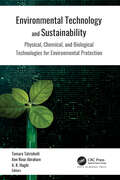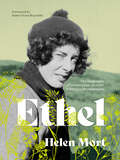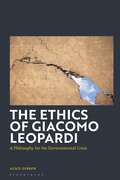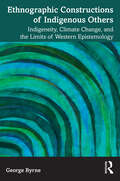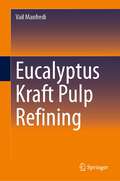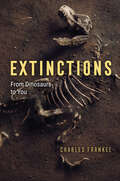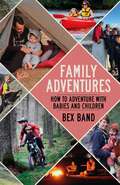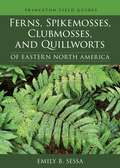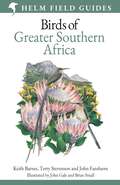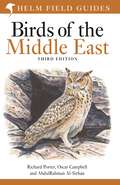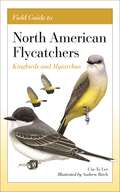- Table View
- List View
Environmental Law in Poland
by Barbara Kowalczyk Rafał Mikowski Łukasz MikowskiDerived from the renowned multi-volume International Encyclopaedia of Laws, this book provides ready access to legislation and practice concerning the environment in Poland. A general introduction covers geographic considerations, political, social and cultural aspects of environmental study, the sources and principles of environmental law, environmental legislation, and the role of public authorities. The main body of the book deals first with laws aimed directly at protecting the environment from pollution in specific areas such as air, water, waste, soil, noise, and radiation. Then, a section on nature and conservation management covers protection of natural and cultural resources such as monuments, landscapes, parks and reserves, wildlife, agriculture, forests, fish, subsoil, and minerals. Further treatment includes the application of zoning and land-use planning, rules on liability, and administrative and judicial remedies to environmental issues. There is also an analysis of the impact of international and regional legislation and treaties on environmental regulation. Its succinct yet scholarly nature, as well as the practical quality of the information it provides, make this book a valuable resource for environmental lawyers handling cases affecting Poland. Academics and researchers, as well as business investors and the various international organizations in the field, will welcome this very useful guide, and will appreciate its value in the study of comparative environmental law and policy.
Environmental Personhood: New Trajectories in Law (New Trajectories in Law)
by Francine RochfordThis book examines the increasingly widespread movement to recognise the environment as a legal person. Several countries have now recognized that nature, or parts of nature, have juristic personhood. In this book, the concept of legal personhood and its incidents are interrogated with a view to determining whether this is, or could be, a positive contribution to modern environmental problems. Surveying historical and current positions on the juristic concept of legal personhood, the book engages recent legislation and case law, in order to consider the attempt in several countries to vest personhood in rivers, river basins and ecosystems. Comparing approaches in a range of countries – including New Zealand, India, Ecuador, the United States and Australia, it addresses the methods employed, the purported aims, the mechanisms for enforcement, and the entrenchment of legal protections. Throughout, the book elicits the difficult relationship between an historically anthropocentric idea of personhood and its extension beyond the human; concluding that the attribution of personhood to the environment is an important, but limited, contribution to environmental sustainability. Accessibly written, this book will appeal to scholars, students and others with interests in environmental law, environmental science and public policy, and ecology more generally.
Environmental Personhood: New Trajectories in Law (New Trajectories in Law)
by Francine RochfordThis book examines the increasingly widespread movement to recognise the environment as a legal person. Several countries have now recognized that nature, or parts of nature, have juristic personhood. In this book, the concept of legal personhood and its incidents are interrogated with a view to determining whether this is, or could be, a positive contribution to modern environmental problems. Surveying historical and current positions on the juristic concept of legal personhood, the book engages recent legislation and case law, in order to consider the attempt in several countries to vest personhood in rivers, river basins and ecosystems. Comparing approaches in a range of countries – including New Zealand, India, Ecuador, the United States and Australia, it addresses the methods employed, the purported aims, the mechanisms for enforcement, and the entrenchment of legal protections. Throughout, the book elicits the difficult relationship between an historically anthropocentric idea of personhood and its extension beyond the human; concluding that the attribution of personhood to the environment is an important, but limited, contribution to environmental sustainability. Accessibly written, this book will appeal to scholars, students and others with interests in environmental law, environmental science and public policy, and ecology more generally.
Environmental Preservation and the Grey Cliffs Conflict: Negotiating Common Narratives, Values, and Ethos
by Kristin D. PickeringBased on a qualitative, ethnographic, observational case study approach, Environmental Preservation and the Grey Cliffs Conflictpresents an analysis of the conflict negotiation between the U.S. Army Corps of Engineers and a local community that struggled to address a deteriorating Corps-managed recreational lake area in Tennessee known as “Grey Cliffs.” Viewing the dispute from the perspective of a new member of the community and a specialist in technical communication and professional writing, Kristin Pickering provides a unique perspective on this communication process. Though environmental degradation and unauthorized use threatened the Grey Cliffs recreational lake area to the point that the Corps considered closure, community members valued it highly and wanted to keep it open. The community near this damaged and crime-ridden area needed help rejuvenating its landscape and image, but the Corps and community were sharply divided on how to maintain this beloved geographic space because of the stakeholders’ different cultural backgrounds and values, as well as the narratives used to discuss them. By co-constructing and aligning narratives, values, and ethos over time—a difficult and lengthy process—the Corps and community succeeded, and Grey Cliffs remains open to all. Focusing on field notes, participant interviews, and analysis of various texts created throughout the conflict, Pickering applies rhetorical analysis and a grounded theory approach to regulation, identity, sustainability, and community values to analyze this communication process. Illustrating the positive change that can occur when governmental organizations and rural communities work together to construct shared values and engage in a rhetoric of relationship that preserves the environment, Environmental Preservation and the Grey Cliffs Conflict provides key recommendations for resolving environmental conflicts within local communities, especially for those working in technical and professional communication, organizational communication, environmental science, and public policy.
Environmental Sociology and Social Transformation: Key Issues (ISSN)
by Rolf Lidskog Magnus BoströmEnvironmental Sociology and Social Transformation demonstrates how sociological theory and research are critical for understanding the social drivers of global environmental destruction and the conditions for transformative change.Written by two professors of sociology who are deeply involved in the international community of environmental sociology, Magnus Boström and Rolf Lidskog argue that we need to better understand society as well as the fundamentally social nature of environmental problems and how they can be addressed. The authors provide answers to why so many unsustainable practices are maintained and supported by institutions and actors despite widespread knowledge of their negative consequences. Employing a pluralistic sociological approach to the study of social transformations, the book is divided into five key themes: Causes, Distributions, Understandings, Barriers, and Transformation. Overall, the book offers an integrative and comprehensive understanding of the social dimension of (un)sustainability, societal inertia, and conditions for transformative change. It provides the reader with references from classic and contemporary sociology and uses pedagogical features including boxes and questions for discussion to help embed learning.Arguing that a broad and deep social transformation is needed to avoid a global civilization crisis, Environmental Sociology and Social Transformation will be a great resource for students and scholars who are exploring current environmental challenges and the societal conditions for meeting them.
Environmental Sociology and Social Transformation: Key Issues (ISSN)
by Rolf Lidskog Magnus BoströmEnvironmental Sociology and Social Transformation demonstrates how sociological theory and research are critical for understanding the social drivers of global environmental destruction and the conditions for transformative change.Written by two professors of sociology who are deeply involved in the international community of environmental sociology, Magnus Boström and Rolf Lidskog argue that we need to better understand society as well as the fundamentally social nature of environmental problems and how they can be addressed. The authors provide answers to why so many unsustainable practices are maintained and supported by institutions and actors despite widespread knowledge of their negative consequences. Employing a pluralistic sociological approach to the study of social transformations, the book is divided into five key themes: Causes, Distributions, Understandings, Barriers, and Transformation. Overall, the book offers an integrative and comprehensive understanding of the social dimension of (un)sustainability, societal inertia, and conditions for transformative change. It provides the reader with references from classic and contemporary sociology and uses pedagogical features including boxes and questions for discussion to help embed learning.Arguing that a broad and deep social transformation is needed to avoid a global civilization crisis, Environmental Sociology and Social Transformation will be a great resource for students and scholars who are exploring current environmental challenges and the societal conditions for meeting them.
Environmental Technology and Sustainability: Physical, Chemical and Biological Technologies for Environmental Protection
by Tamara Tatrishvili Ann Rose Abraham A. K. HaghiThis new title covers the most recent theoretical and practical advancements in green technology for a clean and healthy environment. It aims to provide a better understanding of the research and development of new technologies that are becoming increasingly important for ensuring sustainability.The book provides vital information on advanced materials and green composites and expounds on environmental chemistry for a sustainable world, focusing on different characterization methods as well as new techniques. The volume also considers recent developments and applications of clean energy materials. It presents case studies that emphasize the green technologies being discussed.
Environmental Technology and Sustainability: Physical, Chemical and Biological Technologies for Environmental Protection
This new title covers the most recent theoretical and practical advancements in green technology for a clean and healthy environment. It aims to provide a better understanding of the research and development of new technologies that are becoming increasingly important for ensuring sustainability.The book provides vital information on advanced materials and green composites and expounds on environmental chemistry for a sustainable world, focusing on different characterization methods as well as new techniques. The volume also considers recent developments and applications of clean energy materials. It presents case studies that emphasize the green technologies being discussed.
Ethel: The biography of countryside pioneer Ethel Haythornthwaite
by Helen MortPioneer, activist, environmentalist, poet. Ethel Haythornthwaite is virtually unknown, even in her home town of Sheffield – the UK's outdoor city – yet her tireless campaigning led to the National Parks and Access to the Countryside Act 1949 and the creation of the Peak District National Park, protecting a wild and varied landscape so many have fallen in love with. Founder of a local society to protect rural scenery in 1924, she went on to join the Council for the Preservation of Rural England (CPRE) and become its wartime director. Saviour of the beautiful Longshaw estate, her achievements also include establishing the first green belt in the UK. In Ethel, award-winning author Helen Mort explores the life of this countryside revolutionary who has been overlooked by history. Born into wealth yet frugal, ever restless but infinitely patient, widowed at twenty-two, independent and thoroughly ahead of her time, Ethel Haythornthwaite helped save the British countryside at a time when simply to be a woman was challenge enough. Having been given unrestricted access to Ethel's archive, including hundreds of meticulously written letters, in Ethel, Helen Mort has written letters to Ethel's memory and a paean to her legacy. The beauty and accessibility of the British countryside is the result of passionate campaigning during the inter- and post-war years by groundbreaking figures such as Ethel Haythornthwaite.
The Ethics of Giacomo Leopardi: A Philosophy for the Environmental Crisis
by Alice GibsonProviding a comprehensive introduction to the work of pioneering poet-philosopher Giacomo Leopardi, Alice Gibson pushes his thought into new directions by investigating how his ethics and philosophy of nature offer means for understanding and taking responsibility for the environmental crisis.Through examination of the whole of Leopardi's oeuvre, from the Zibaldone to the poems he wrote towards the end of his life, this book disrupts the common image of Leopardi as a pessimist poet whose works contribute to the nihilistic tradition. The Ethics of Giacomo Leopardi instead uncovers his forward-looking views on living in a multispecies world, in which humans live alongside other living beings in a delicate ecosystem that not only requires respect, but also instigates wonder.Bringing Leopardi's thought into dialogue with contemporary ecological theorists such as Donna Haraway, Bruno Latour, and Timothy Morton, Gibson reveals how a Leopardian ethics of solidarity, compassion and community is the guide we need today to reframe our relationship with nature.
Ethnographic Constructions of Indigenous Others: Indigeneity, Climate Change, and the Limits of Western Epistemology
by George ByrneThis book examines the ways in which indigeneity interacts with climate change politics at multiple levels and at the same time offers a self-critical reflection on the role of ethnographic research (and researchers) in this process. Through a multi-sited ethnography, it shows how indigeneity and climate change mitigation are at this point so intensely intertwined that one cannot be clearly understood without considering the other. While indigenous identities have been (re)defined in relation to climate change, it argues that Indigenous Peoples continue to subvert pervasive notions of the nature/culture dichotomy and disrupt our understanding of what it means to be human in relation to nature. It encourages students and researchers in anthropology, international development, and other related fields to engage in more meaningful reflection on the epistemic shortcomings of “the West”, including in our own research, and to acknowledge the ongoing role of power, coloniality, extractivism, and whiteness in climate change discourses.
Ethnographic Constructions of Indigenous Others: Indigeneity, Climate Change, and the Limits of Western Epistemology
by George ByrneThis book examines the ways in which indigeneity interacts with climate change politics at multiple levels and at the same time offers a self-critical reflection on the role of ethnographic research (and researchers) in this process. Through a multi-sited ethnography, it shows how indigeneity and climate change mitigation are at this point so intensely intertwined that one cannot be clearly understood without considering the other. While indigenous identities have been (re)defined in relation to climate change, it argues that Indigenous Peoples continue to subvert pervasive notions of the nature/culture dichotomy and disrupt our understanding of what it means to be human in relation to nature. It encourages students and researchers in anthropology, international development, and other related fields to engage in more meaningful reflection on the epistemic shortcomings of “the West”, including in our own research, and to acknowledge the ongoing role of power, coloniality, extractivism, and whiteness in climate change discourses.
Eucalyptus Kraft Pulp Refining
by Vail ManfrediThis book presents a brief history of papermaking followed by comments regarding wood as a source of fibers, including its chemical and anatomical characteristics and the influence of these aspects on the quality of the pulp produced. In addition, the author describes the effects of the pulping process, mainly a chemical process, on pulp quality and how these wood characteristics influence both the refining process as the quality of the final paper. The book further provides a broad discussion, based on experimental results, on the contribution of the main operating refining variables and the main strategies that can be used industrially to optimize the operating results. From this evaluation, the parameter that complements the specific edge load theory is identified. This parameter is related to the retention time of the fiber flocs inside the refiner.
European Union Case Law on the Birds and Habitats Directives (Energy and Environmental Law and Policy Series)
by Nina Claudia Miron Liam CashmanEnergy and Environmental Law and Policy Series Despite the remarkable scope of EU conservation policy, and notwithstanding 30 years of relevant case law, nature in the EU continues to decline. This comprehensive book, focusing on the EU’s core legislation on nature, the Birds and Habitats Directives, presents a detailed summary and analysis of the two directives as interpreted by the Court of Justice of the European Union. The book’s systematic structure provides the crucial details of a large body of cases decided by the Court following legal actions taken by the European Commission or preliminary references submitted by national courts. It enables a clear procedural understanding of how nature cases are brought before the Court and how the Court approaches matters such as the burden of proof and the entitlement of environmental associations to litigate disputes. Among the salient areas of analysis are the following: the requirements for including sites within Natura 2000, the largest network of protected nature areas in the world; the obligations to conserve Natura 2000 sites and protect them from damage, including through procedural and substantive assessment requirements for plans and projects; requirements concerning unlawful or illegal activities; the strict protection requirements that apply to wild birds and other species, together with related derogation provisions; requirements to protect habitats in the wider countryside and interlinkages between the nature directives and directives on impact assessment, water, and environmental liability; challenges addressed or influenced by the Court, such as defects in Member State transposition, problems of monitoring and enforcing compliance, and dealing with harmful and benign subsidies; procedures used to bring cases to the Court, including direct actions by the Commission and preliminary references from national courts. According to the 2020 Global Risk Report of the World Economic Forum, biodiversity loss will be one of the biggest threats facing humanity in the next ten years. If nature is to have any hope of recovering and prospering, strict application of existing nature conservation rules is of utmost importance, especially as a recent evaluation shows that, although the EU nature directives are fit for purpose, implementation on the ground is lagging behind. By setting out the case law systematically and explaining what compliance with specific requirements entails, this book makes a signal contribution to nature conservation practice. Lawyers, policymakers, and NGOs working in the domain of nature conservation will greatly benefit.
The Evolution of Gerald Durrell: Biography of an Author and Wildlife Conservationist
by Professor Mary Sanders PollockIn The Evolution of Gerald Durrell: A Naturalist's Critical Biography, Mary Sanders Pollock revisits the life and work of Gerald Durrell, one of the most significant environmentalist figures of the 20th century. This new biography tracks Durrell's evolution from a free-range childhood on Corfu through his time in Africa, South America, and the islands of the Pacific and Indian Oceans. Durrell's early work is described in his numerous travel narratives, but his conservation activities culminated in “the stationary ark,” a conservation zoo on the Isle of Jersey which still plays an important role in global wildlife conservation efforts. This biography situates Durrell's writing, collecting, and conservation practices within the frameworks of animal studies, conservation biology, and postcolonial history. Familiarizing readers with the broad range of his cultural impact, from The Corfu Trilogy to his BBC television specials, Pollock shows how Durrell's approach offers models for how life on earth is to thrive and survive: scientists must make greater efforts to touch hearts and minds, and cultural workers must communicate more about science and the perilous existence of other species.
Exploring Climate Change Related Systems and Scenarios: Preconditions for Effective Global Responses (Routledge Advances in Climate Change Research)
by Jeremy Winston WebbJeremy Webb draws on multiple disciplines to piece together the climate change puzzle, identifying what it would take to limit climate change and its impacts.The book starts with a summary of the climate change problem and develops a Climate Change, National Interests, International Cooperation (CCNIIC) model of the climate response system. Webb reviews ‘reverse stress testing’, ‘backcasting’, and ‘theory of change’ methods, showing how they can be used to collect a large sample of possible futures. He also shows how we can explore the multiverse of futures using a new method called thematic chain analysis, finding relevant connections across scenarios. In the second half of the book, Webb explores 175 scenarios collected through 27 interviews with climate change experts. From these scenarios a signal response model is developed. Preconditions for effective social change and behaviour, political will and policy, as well as business and economic activity are synthesised. Lessons include preconditions for effective global responses to climate change, showing what it takes to limit climate change and related impacts. The book finishes with an epilogue, applying the signal response model and preconditions for effective global responses to COVID-19, demonstrating that models from this book can be applied to other global response problems – and used to quickly assess possible response strategies.This book will be of great interest to students and scholars of climate change, environmental policy and future studies.
Exploring Climate Change Related Systems and Scenarios: Preconditions for Effective Global Responses (Routledge Advances in Climate Change Research)
by Jeremy Winston WebbJeremy Webb draws on multiple disciplines to piece together the climate change puzzle, identifying what it would take to limit climate change and its impacts.The book starts with a summary of the climate change problem and develops a Climate Change, National Interests, International Cooperation (CCNIIC) model of the climate response system. Webb reviews ‘reverse stress testing’, ‘backcasting’, and ‘theory of change’ methods, showing how they can be used to collect a large sample of possible futures. He also shows how we can explore the multiverse of futures using a new method called thematic chain analysis, finding relevant connections across scenarios. In the second half of the book, Webb explores 175 scenarios collected through 27 interviews with climate change experts. From these scenarios a signal response model is developed. Preconditions for effective social change and behaviour, political will and policy, as well as business and economic activity are synthesised. Lessons include preconditions for effective global responses to climate change, showing what it takes to limit climate change and related impacts. The book finishes with an epilogue, applying the signal response model and preconditions for effective global responses to COVID-19, demonstrating that models from this book can be applied to other global response problems – and used to quickly assess possible response strategies.This book will be of great interest to students and scholars of climate change, environmental policy and future studies.
Exploring Ecolinguistics: Ecological Principles and Narrative Practices (Bloomsbury Advances in Ecolinguistics)
by Douglas Mark PontonContributing to the rapidly emerging field of ecolinguistics, this book explores the role of language in mediating and determining our relationship with nature and in shaping attitudes and social practices in environmental areas. In doing so, it maps out research pathways for informed ecological debate that concerns both the planet and the discipline.The book centres on two case studies. The first is a nature reserve near Siracusa in Sicily run by Fabio Cilea, where flamingos have begun to breed despite the devastation of the nearby coastline by one of the largest petro-chemical plants in Europe. The second is High Ash farm, a small farm near Norwich, UK. Farmer, Chris Skinner, is a passionate naturalist who for 30 years has presented a programme on BBC Radio Norfolk. Through analysing the discourse of both Skinner and Cilea, the book explores what it can reveal about the underlying environmental visions that sustain them. Together with the discourse of other engaged ecological figures, a picture emerges of the connections that exist between our beliefs/attitudes, language and the natural world.Presenting a framework for analysing environmental discourse from a primarily positivist standpoint, the book draws attention to the discourses that underline social practices felt to be useful, necessary and beneficial in these moments of environmental crisis. Although these contexts are European, the methodologies applied, as well as the ecological and linguistic issues dealt with, are universal, clarifying the relationship between social practices and language itself, viewed in the book as an ecosystem that is also in need of loving attention.
Extinctions: From Dinosaurs to You
by Charles FrankelA compelling answer to an important question: Can past mass extinctions teach us how to avoid future planetary disaster? On its face, the story of mass extinction on Earth is one of unavoidable disaster. Asteroid smashes into planet; goodbye dinosaurs. Planetwide crises seem to be beyond our ability to affect or evade. Extinctions argues that geological history tells an instructive story, one that offers important signs for us to consider. When the asteroid struck, Charles Frankel explains, it set off a wave of cataclysms that wore away at the global ecosystem until it all fell apart. What if there had been a way to slow or even turn back these tides? Frankel believes that the answer to this question holds the key to human survival. Human history, from the massacre of Ice Age megafauna to today’s industrial climate change, has brought the planet through another series of cataclysmic events. But the history of mass extinction together with the latest climate research, Frankel maintains, shows us a way out. If we curb our destructive habits, particularly our drive to kill and consume other species, and work instead to conserve what biodiversity remains, the Earth might yet recover. Rather than await decisive disaster, Frankel argues that we must instead take action to reimagine what it means to be human. As he eloquently explains, geological history reminds us that life is not eternal; we can disappear, or we can become something new and continue our evolutionary adventure.
Extinctions: From Dinosaurs to You
by Charles FrankelA compelling answer to an important question: Can past mass extinctions teach us how to avoid future planetary disaster? On its face, the story of mass extinction on Earth is one of unavoidable disaster. Asteroid smashes into planet; goodbye dinosaurs. Planetwide crises seem to be beyond our ability to affect or evade. Extinctions argues that geological history tells an instructive story, one that offers important signs for us to consider. When the asteroid struck, Charles Frankel explains, it set off a wave of cataclysms that wore away at the global ecosystem until it all fell apart. What if there had been a way to slow or even turn back these tides? Frankel believes that the answer to this question holds the key to human survival. Human history, from the massacre of Ice Age megafauna to today’s industrial climate change, has brought the planet through another series of cataclysmic events. But the history of mass extinction together with the latest climate research, Frankel maintains, shows us a way out. If we curb our destructive habits, particularly our drive to kill and consume other species, and work instead to conserve what biodiversity remains, the Earth might yet recover. Rather than await decisive disaster, Frankel argues that we must instead take action to reimagine what it means to be human. As he eloquently explains, geological history reminds us that life is not eternal; we can disappear, or we can become something new and continue our evolutionary adventure.
Family Adventures: How to adventure with babies and children
by Bex BandA practical guide to involving babies and children in all sorts of adventures, whether it be cycling, camping, paddling, hiking, swimming or outdoor holidays.As soon as Bex Band, founder of the UK's largest women's adventure community, Love Her Wild, announced she was pregnant with her first child, the sympathy began. 'Enjoy your adventures while you can', 'It's going to be a big shock not being able to travel as much', and 'Aren't you going to miss adventuring?'It seemed as though having children was a death sentence when you're an outdoor adventurer. But it really doesn't have to be that way. Yes, it's a scary prospect – how do you keep them safe? Where do they sleep? What equipment do you need? - but it's totally doable. When Bex's daughter was just a few weeks old, Bex and her husband took her camping. Now age 2, she's been wild camping on Dartmoor, cycling along the coast, swimming in rural lakes and even carried in a backpack on a multi-day Negev desert hike. Now, she shares her stories and insights in Family Adventures, a practical and inspirational guide to involving babies and children in outdoor adventures. This guide is full of useful information (such as what to pack when camping with an infant or how to keep children safe in open water), invaluable tips (family games you can play around a campfire or how to keep morale up in bad weather) and plenty of honesty around things going wrong (poo-explosion on a wild camp, anyone?). Experiences from adventuring families also provide a plethora of insights so that you're well equipped to make your family adventuring dreams a reality.
Ferns, Spikemosses, Clubmosses, and Quillworts of Eastern North America (Princeton Field Guides #150)
by Emily SessaA comprehensive, richly illustrated photographic field guide to the ferns and lycophytes of the eastern United States and CanadaThis is a comprehensive photographic field guide to the ferns, spikemosses, clubmosses, and quillworts of eastern North America. Accessible yet scientifically accurate, the book will appeal to beginners and experts alike and enhance the field experience of any user.Keys, range maps, detailed color photographs, and facing-page species descriptions aid exploration and allow reliable identification of all 305 species found in the area covered by the book—the United States east of the Mississippi and contiguous Canada, except for extreme northern and northeastern Canada. An introduction provides an easy-to-understand overview of identifying characteristics, life cycles, and evolutionary history. Checklists allow readers to record species they have seen, in four subregions. Indexes feature a complete list of common and scientific names, including synonyms, ensuring that users can find the plants they are looking for and keep track of changes in taxonomy. In addition, information about hybrids, polyploids, and reticulate relationships is provided, illuminating the fascinating processes that have led to such a rich diversity of species.Modern and innovative, this is the definitive guide to the ferns and lycophytes of eastern North America.Covers all 305 species, belonging to 96 genera and 30 familiesFeatures detailed color photos of all species—and facing-page species descriptionsProvides checklists for keeping track of species seenIncludes common and scientific names and notable synonyms
Field Guide to Birds of Greater Southern Africa (Helm Field Guides)
by Mr Keith Barnes Terry Stevenson John FanshaweThis spectacular field guide includes all resident, breeding and migrant species found in Greater Southern Africa.Comprising South Africa, Lesotho, eSwatini, Namibia, Botswana, Zimbabwe, Malawi, Mozambique and Zambia, Greater Southern Africa is a vast region home to a truly extraordinary diversity of avifauna.The latest in the Helm Field Guide series, Birds of Greater Southern Africa describes all 1,170 regularly occurring species that are likely to be encountered in the region, from the Wandering Albatross to the Pennant-winged Nightjar. Featuring 272 colour plates by three of the world's leading bird illustrators, this practical guide also includes concise species accounts describing key identification features, status, range, habitat and voice; distribution maps for each species are also included.Fully illustrated throughout, this is an essential reference guide for anyone visiting or living in this wildlife-rich area.
Field Guide to Birds of the Middle East: Third Edition (Helm Field Guides)
by Richard Porter Oscar Campbell Mr AbdulRahman Al-SirhanThe ultimate field guide to the birds of the Middle East, an indispensable companion for any traveller to the region The Middle East – the region stretching from Cyprus and the Levant to Iran, including Turkey and the Arabian Peninsula, plus Socotra – has a wonderfully broad and diverse avifauna, featuring a host of wintering and passage migrants, enigmatic breeders, and even a few endemics that occur nowhere else. This authoritative book covers more than 895 species recorded in the Middle East, including details of all regular visitors and breeding species, from the Purple Sunbird to the Northern Bald Ibis. Featuring 180 stunning colour plates by three of the world's leading bird illustrators, this practical guide also includes concise species accounts describing key identification features, status, range, habitat and voice with fully updated distribution maps for each species. Written by three of the leading lights in regional ornithology and conservation, this fully revised and expanded guide is an essential reference for any birder living in or visiting the Middle East.
Field Guide to North American Flycatchers: Kingbirds and Myiarchus
by Cin-Ty LeeA richly illustrated, portable guide to two of the most challenging groups of flycatchers to identify in the fieldThe identification of flycatchers can be a daunting challenge for even the most seasoned birder. The Field Guide to North American Flycatchers series takes bird identification to an entirely new level by training readers to observe subtle differences in structure, color patterns, and vocalizations before delving into the finer details of a particular species.Because the plumages of flycatchers are so similar, this innovative guide uses illustrations that highlight slight variations among species that photos often miss. One of the last frontiers of bird identification is now accessible to everyone—once one knows what to look for.Uses a holistic approach that makes flycatcher identification possible even for beginnersFeatures a wealth of beautiful illustrations that depict every species in North AmericaShows how to observe subtle differences in structure, plumage contrasts, and vocalizations, which together create a distinctive overall impression of the birdIncludes detailed audio spectrograms and seasonal distribution maps for each speciesShares invaluable tips for successful identification in all kinds of field settingsCompact and field-friendly—the ideal travel companion for any birderThis guide is dedicated to kingbirds and Myiarchus flycatchers. Combined with the first volume in this identification series, which focuses on Empidonax flycatchers and pewees, these companion guides are the most comprehensive and accessible treatments of flycatcher identification to date.




